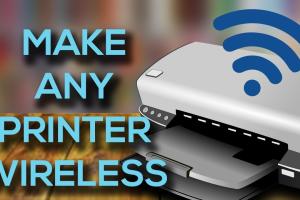Effortlessly Convert Your Printer to Wireless Using a Router

-
Quick Links:
- Introduction
- Understanding Wireless Printers
- Benefits of Wireless Printing
- Requirements for Making a Printer Wireless
- Step-by-Step Guide to Make Your Printer Wireless
- Troubleshooting Common Issues
- Case Studies and Expert Insights
- Conclusion
- FAQs
Introduction
In today's digital age, the convenience of wireless printing is a necessity for many users. Not only does it reduce clutter, but it also allows for seamless printing from multiple devices. Whether you're working from home or need to print documents from your smartphone, making your printer wireless can significantly enhance your productivity. In this comprehensive guide, we will explore simple ways to convert your traditional printer into a wireless device using a wireless router.
Understanding Wireless Printers
Wireless printers are devices that can connect to a computer or network without the need for physical cables. They typically use Wi-Fi or Bluetooth technologies to establish a connection. However, not all printers come with built-in wireless capabilities. If you have an older model, you might think you are out of luck. Fortunately, there are several methods to make even non-wireless printers connect through a wireless router.
Benefits of Wireless Printing
- Convenience: Print from anywhere in your home or office without being tethered to a device.
- Multiple Device Connectivity: Connect various devices like laptops, tablets, and smartphones.
- Space-Saving: Reduce cable clutter and optimize your workspace.
- Increased Mobility: Print on the go, using your mobile device.
Requirements for Making a Printer Wireless
Before you begin, ensure you have the following:
- A printer (preferably a USB printer)
- A wireless router with an active internet connection
- Compatible drivers installed on your computer
- A computer or mobile device to configure the printer settings
Step-by-Step Guide to Make Your Printer Wireless
Step 1: Connect Your Printer to the Router
Using a USB cable, connect your printer to the wireless router. Most routers have a USB port specifically for this purpose.
Step 2: Access Router Settings
Open a web browser on your computer and enter the router's IP address (usually found on the back of the router) to access the admin panel.
Step 3: Configure Printer Settings
In the router settings, locate the section for connected devices. You should see your printer listed there. Follow the instructions to enable wireless printing.
Step 4: Install Printer Drivers
On your computer, install the necessary printer drivers. You can usually find these on the manufacturer's website. Make sure to select the wireless option during installation.
Step 5: Connect Your Devices
Now that your printer is configured, connect your devices to the same Wi-Fi network as your printer. You can now print wirelessly from any connected device.
Troubleshooting Common Issues
Even with the best setup, you may encounter issues. Here are some common problems and solutions:
- Printer Not Detected: Ensure the printer is powered on and connected to the router.
- Slow Printing: Check your Wi-Fi connection and ensure no other devices are hogging bandwidth.
- Driver Issues: Reinstall the printer drivers if they are outdated or incompatible.
Case Studies and Expert Insights
In a recent survey by PCMag, 78% of users reported increased productivity after switching to a wireless printing setup. Users noted that being able to print from anywhere in their home made the process much more efficient, especially for families juggling multiple devices.
Experts recommend that users regularly check their router's firmware for updates to ensure optimal performance and security. According to Digital Trends, a well-maintained network contributes to faster and more reliable printing.
Conclusion
Making your printer wireless is a straightforward process that can significantly enhance your printing experience. By following the steps outlined in this guide, you can enjoy the freedom and convenience of wireless printing in no time. Remember to keep your devices updated and troubleshoot any issues as they arise to maintain a smooth operation.
FAQs
1. Can I make any printer wireless?
Most USB printers can be made wireless by connecting them to a router, but check your printer's compatibility for best results.
2. What if my printer doesn’t have a USB port?
Some printers can be connected wirelessly using Bluetooth, or you may need to consider a wireless print server.
3. How do I know if my printer is compatible with wireless printing?
Check the manufacturer's specifications or user manual for wireless capability or USB connection options.
4. Can I print from my smartphone?
Yes! As long as your printer is connected to the same Wi-Fi network, you can print from your smartphone.
5. Is wireless printing secure?
As with any wireless network, security depends on your router's settings. Ensure you have a strong password and updated firmware.
6. What are common issues with wireless printers?
Common issues include connectivity problems, slow printing speeds, and outdated drivers.
7. Do I need to install software to print wirelessly?
Yes, most printers require drivers or software to be installed on your computer or device for wireless printing.
8. How often should I update my printer drivers?
It's best to check for updates at least once every few months or when you experience issues.
9. Can I connect multiple devices to the same printer?
Absolutely! Most wireless printers allow multiple devices to connect and print simultaneously.
10. What if I change my Wi-Fi network?
You will need to reconnect your printer to the new Wi-Fi network through the router settings.
Random Reads
- Mastering image editing in powerpoint your ultimate guide
- How to respond to laughing emojis
- How to recover deleted history from your browser
- Unclog drain baking soda vinegar
- Mastering the art of folding and storing your ironing board
- How to test continuity with a multimeter
- How to test for mold
- Remove reshade windows
- Remove read only ms word
- Mastering video editing guide